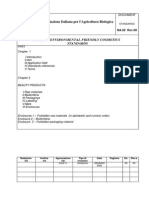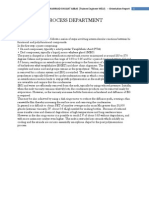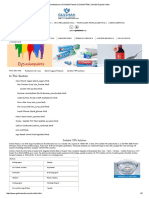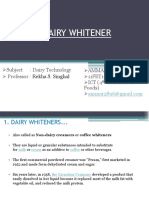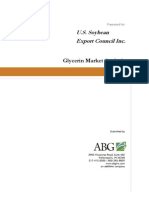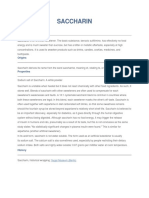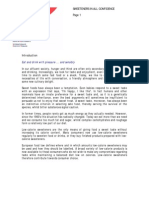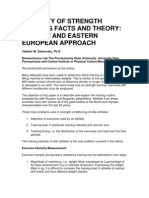0 ratings0% found this document useful (0 votes)
90 viewsMannitol
Mannitol
Uploaded by
Zinedin AzMannitol is a sugar alcohol that can be derived from mannose through hydrogenation. It is commonly produced industrially via hydrogenation of fructose using a Raney nickel catalyst, which results in a mixture of mannitol and sorbitol. Mannitol has various uses as a food additive, in medical applications, and as a cutting agent. Research is ongoing to develop more efficient microbial pathways for mannitol production.
Copyright:
© All Rights Reserved
Available Formats
Download as DOCX, PDF, TXT or read online from Scribd
Mannitol
Mannitol
Uploaded by
Zinedin Az0 ratings0% found this document useful (0 votes)
90 views5 pagesMannitol is a sugar alcohol that can be derived from mannose through hydrogenation. It is commonly produced industrially via hydrogenation of fructose using a Raney nickel catalyst, which results in a mixture of mannitol and sorbitol. Mannitol has various uses as a food additive, in medical applications, and as a cutting agent. Research is ongoing to develop more efficient microbial pathways for mannitol production.
Original Description:
mannitol
Copyright
© © All Rights Reserved
Available Formats
DOCX, PDF, TXT or read online from Scribd
Share this document
Did you find this document useful?
Is this content inappropriate?
Mannitol is a sugar alcohol that can be derived from mannose through hydrogenation. It is commonly produced industrially via hydrogenation of fructose using a Raney nickel catalyst, which results in a mixture of mannitol and sorbitol. Mannitol has various uses as a food additive, in medical applications, and as a cutting agent. Research is ongoing to develop more efficient microbial pathways for mannitol production.
Copyright:
© All Rights Reserved
Available Formats
Download as DOCX, PDF, TXT or read online from Scribd
Download as docx, pdf, or txt
0 ratings0% found this document useful (0 votes)
90 views5 pagesMannitol
Mannitol
Uploaded by
Zinedin AzMannitol is a sugar alcohol that can be derived from mannose through hydrogenation. It is commonly produced industrially via hydrogenation of fructose using a Raney nickel catalyst, which results in a mixture of mannitol and sorbitol. Mannitol has various uses as a food additive, in medical applications, and as a cutting agent. Research is ongoing to develop more efficient microbial pathways for mannitol production.
Copyright:
© All Rights Reserved
Available Formats
Download as DOCX, PDF, TXT or read online from Scribd
Download as docx, pdf, or txt
You are on page 1of 5
CHEMICAL INDUSTRY PROCESS
MANNITOL
Monica Yulfarida 21030116130166
Zinedin Abdi Zidan 21030116120044
MANNITOL
A. Introduction
Mannitol is classified as a sugar alcohol. It can be derived from a sugar
(mannose) by reduction other sugar alcohols include xylitol and sorbitol. Mannitol
and sorbitol are isomers, the only difference being the orientation of the hydroxyl
group on carbon 2.
B. Raw Materials
Mannitol is the most abundant polyol in nature. It is produced by bacteria,
yeasts, fungi, algae, lichens and many plants (Wisselink et al., 2002). Mannitol is
about half as sweet as sucrose, mostly not metabolized by humans and therefore
considered as a low-calorie sweetener (Soetaert et al., 1999).
Mannitol is commonly produced via the hydrogenation of fructose, which is
formed from either starch or sucrose (common table sugar). Although starch is a
cheaper source than sucrose, the transformation of starch is much more complicated.
Its sweetness is approximately half as compared to sucrose. However, like other sugar
alcohols, mannitol exhibits reduced caloric values compared to that of sucrose,
making it applicable as sweeteners in so-called light foods.
C. Process and Description
Mannitol is produced industrially by high pressure hydrogenation of fructose
and glucose- fructose mixtures in aqueous solution at high temperature (120160 C)
with Raney nickel catalyst. -Fructose gets converted to mannitol and -fructose is
converted to sorbitol where as glucose is exclusively hydrogenated to sorbitol. Due to
poor selectivity of the nickel catalyst, hydrogenation of 50:50 fructose:glucose
mixture results in an approximately 25:75 mixture of mannitol and sorbitol (Saha &
Racine, 2011). Even when pure fructose is catalytically hydrogenated, only about
50% of it is converted into mannitol, whereas the rest is converted into sorbitol.
Chemical hydrogenation process has several limitations, including the need for
highly purified substrates, high reaction temperatures and pressures, costly
purification steps and a poor mannitol yield.
Further research is being conducted, studying ways to engineer even more
efficient mannitol pathways in lactic acid bacteria, as well as the use of other
microorganisms such as yeast and E. coli in mannitol production. When food-grade
strains of any of the aforementioned microorganisms are used, the mannitol and the
organism itself are directly applicable to food products, avoiding the need for careful
separation of microorganism and mannitol crystals.
Several lactic acid bacterial strains are known to produce mannitol. Its
production by food-grade lactic acid bacteria offers important advantages. Firstly,
their products are directly applicable in food products, without any restriction.
Secondly, there is no need for a careful separation of products and microorganisms.
Thirdly, some LABs are claimed as beneficial in the gastrointestinal tract. Mannitol
production by those bacteria may strengthen their health-promoting ability.
D. Block Diagram
Figure 1. Block Diagram of Mannitol
E. Flow Sheet
Figure 2. Flow Sheet of Mannitol Production
F. Specification
Figure 3. Specification of Mannitol
G. Uses of Mannitol
Major applications of mannitol are:
1. Food industry as a food additive. It is used as a sweet-tasting, bodying and
texturing agent.
2. The primary ingredient of mannitol salt agar, a bacterial growth medium, and is
used in others.
3. Increases blood glucose to a lesser extent than sucrose,so is used as a sweetener
for people with diabetes, and in chewing gums.
4. Popularly used as a cutting agent in cocaine.
H. REFERENCES
Saha, B., Racine, F. 2011. Biotechnological production of mannitol and its
applications. Applied microbiology and biotechnology, 89(4), 879-891.
Soetaert, W., Vanhooren, P., Vandamme, E. 1999. Production of mannitol by
fermentation. Methods Biotechnol, 10, 261-275.
Wisselink, H.W., Weusthuis, R.A., Eggink, G., Hugenholtz, J., Grobben, G.J. 2002.
Mannitol production by lactic acid bacteria: a review. International Dairy
Journal, 12(2-3), 151-161.
You might also like
- VizDocument52 pagesVizNuno Gomes50% (2)
- Info SorbitolDocument45 pagesInfo SorbitolSanti CarpNo ratings yet
- AIAB Cosmetics StandardsDocument22 pagesAIAB Cosmetics Standardsdade1964No ratings yet
- AWT Pectin As Gelling AgentDocument4 pagesAWT Pectin As Gelling AgentDayana AriasNo ratings yet
- Beverage Application Guide: Cellulose GumDocument4 pagesBeverage Application Guide: Cellulose GumGiorgi GhambashidzeNo ratings yet
- AWHONN High-Risk & Critical Care Obstetrics (2012)Document440 pagesAWHONN High-Risk & Critical Care Obstetrics (2012)Rima Hajjar100% (2)
- Advances in Dairy ProductsFrom EverandAdvances in Dairy ProductsFrancesco ContoNo ratings yet
- Progress in Food PreservationFrom EverandProgress in Food PreservationRajeev BhatNo ratings yet
- Dow OpacifiersDocument27 pagesDow OpacifiersAlfonso Dominguez Gonzalez100% (1)
- Sor BitolDocument60 pagesSor BitolRebekah Schmidt100% (1)
- Gellan Gum Fermentative Production, DownstreamprocessingDocument14 pagesGellan Gum Fermentative Production, DownstreamprocessingM KaedeNo ratings yet
- Saccharin: - Remsen and FahlbergDocument3 pagesSaccharin: - Remsen and FahlbergKhushbuChemical RautNo ratings yet
- Conversion of Corn Stover To EnergyDocument14 pagesConversion of Corn Stover To EnergySalamiel Blyte BalladNo ratings yet
- Process Department: MOHAMMAD SHUJJAT ABBAS (Trainee Engineer M&U) - Orientation ReportDocument4 pagesProcess Department: MOHAMMAD SHUJJAT ABBAS (Trainee Engineer M&U) - Orientation ReportShujjat AbbasNo ratings yet
- What Is Meant by Oligo Maltose AnswerDocument6 pagesWhat Is Meant by Oligo Maltose AnswerMathaios VadilisNo ratings yet
- Pectin Production and Global MarketDocument5 pagesPectin Production and Global MarketMachaiah M.DNo ratings yet
- Sugar Syrups From MaizeDocument8 pagesSugar Syrups From Maizesyenikeyev3220No ratings yet
- Crystallization 0f SorbitolDocument5 pagesCrystallization 0f SorbitolPiso VươngNo ratings yet
- Oil Migration in ChocolateDocument8 pagesOil Migration in ChocolateKenesei György100% (1)
- IsomaltDocument22 pagesIsomaltPanneerselvam Dhanushkodi100% (1)
- Standard Chocolate Milk Shake@IFFDocument2 pagesStandard Chocolate Milk Shake@IFFsubhra bhattacharjee0% (1)
- Manufacturers of Sorbitol Powder - Sorbitol 70% - Sorbitol Exporter IndiaDocument2 pagesManufacturers of Sorbitol Powder - Sorbitol 70% - Sorbitol Exporter IndiahtgfhgvmNo ratings yet
- Modified CelluloseDocument19 pagesModified CelluloseK V SATHEESHKUMAR MECHNo ratings yet
- Edible Films and Coatings Sources Properties and ApplicationDocument12 pagesEdible Films and Coatings Sources Properties and ApplicationDanielNo ratings yet
- Journal of Polymer Science Part A - Polymer Chemistry Volume 38 Issue 23 2000 (Doi 10.1002/1099-0518 (20001201) 38:23-4206::aid-Pola60-3.0.Co 2-E) Michael J. Monteiro Marie Sjöberg JeDocument12 pagesJournal of Polymer Science Part A - Polymer Chemistry Volume 38 Issue 23 2000 (Doi 10.1002/1099-0518 (20001201) 38:23-4206::aid-Pola60-3.0.Co 2-E) Michael J. Monteiro Marie Sjöberg JeAreerietinqitink Onenkonenk TazqimaninaaNo ratings yet
- Engineers India - EIRI HiTech Magazine - May 2018Document17 pagesEngineers India - EIRI HiTech Magazine - May 2018Sunesh SharmaNo ratings yet
- Starch Sector Report - AASPL - 23-07-10Document15 pagesStarch Sector Report - AASPL - 23-07-10DFrancis007No ratings yet
- Dairy Whitener: Rekha S. SinghalDocument13 pagesDairy Whitener: Rekha S. SinghalAbbas SaqibNo ratings yet
- Project On AB MauriDocument50 pagesProject On AB MauriVarunKhandigeNo ratings yet
- Functionlsity Starch in Snak Food1-2Document21 pagesFunctionlsity Starch in Snak Food1-2Adinda LarasatiNo ratings yet
- Melt CrystallizationDocument10 pagesMelt CrystallizationBryan DallaraNo ratings yet
- Fulltext 12088 PDFDocument83 pagesFulltext 12088 PDFkharajurgNo ratings yet
- AWT Pectin Amid CS 005Document8 pagesAWT Pectin Amid CS 005Dayana AriasNo ratings yet
- Fat Bloom in Chocolate and Compound CoatingsDocument34 pagesFat Bloom in Chocolate and Compound Coatingssharfina02No ratings yet
- Food Hydrocolloid Edible Films and CoatingsDocument34 pagesFood Hydrocolloid Edible Films and CoatingsLiani FarahanaNo ratings yet
- Fat Bloom in Chocolate and Compound CoatingDocument34 pagesFat Bloom in Chocolate and Compound CoatingSartika Mutiarasani100% (1)
- Glycerin Market Analysis - FinalDocument35 pagesGlycerin Market Analysis - Finalnitishm1711100% (1)
- Cross-Linking Starch at Various Moisture Contents by PhosphateDocument4 pagesCross-Linking Starch at Various Moisture Contents by PhosphateMateo Torres TorresNo ratings yet
- Multivitamins: Childrens Gummy BearDocument12 pagesMultivitamins: Childrens Gummy BearKaylie ConnollyNo ratings yet
- ADM and Biofuels Brochure LoresDocument16 pagesADM and Biofuels Brochure LoresHidayat Sukarni100% (1)
- Natural Ingredients-Based Gummy Bear Composition Designed According To Texture Analysis and Sensory Evaluation in VivoDocument16 pagesNatural Ingredients-Based Gummy Bear Composition Designed According To Texture Analysis and Sensory Evaluation in VivoMargarita LópezNo ratings yet
- Characterization of PectinDocument10 pagesCharacterization of PectinJames Aaron SantiagoNo ratings yet
- Icing SugarDocument2 pagesIcing Sugars.sabapathy100% (1)
- Sweeteners Teaching 2013Document9 pagesSweeteners Teaching 2013Karen_suzzyNo ratings yet
- The Specialists For Pectin 09Document36 pagesThe Specialists For Pectin 09Dayana AriasNo ratings yet
- Saccharin PDFDocument3 pagesSaccharin PDFsiap scribdNo ratings yet
- Artificial Sweeteners Aspartame, SaccharinDocument18 pagesArtificial Sweeteners Aspartame, SaccharinkhnumdumandfullofcumNo ratings yet
- Citric Acid Production PDFDocument5 pagesCitric Acid Production PDFDr.Neelam JainNo ratings yet
- Nutela WikiDocument3 pagesNutela WikinecitacNo ratings yet
- Unit 11 Softy and Novelties - Definition, Composition, Legal Standards and Method of ManufactureDocument15 pagesUnit 11 Softy and Novelties - Definition, Composition, Legal Standards and Method of ManufactureRonak RawatNo ratings yet
- Topical and Prospective Processes of Acetoxylation: Grzegorz Lewandowski, Marcin Bartkowiak, Eugeniusz MilchertDocument6 pagesTopical and Prospective Processes of Acetoxylation: Grzegorz Lewandowski, Marcin Bartkowiak, Eugeniusz MilchertAnonymous b9fcR5No ratings yet
- PofsdkjnlkldsgDocument258 pagesPofsdkjnlkldsgzakizahirsyahNo ratings yet
- SelvolPVOH EmulsionPolymerization en PVOHDocument9 pagesSelvolPVOH EmulsionPolymerization en PVOHNelson BarriosNo ratings yet
- AWT Use of H F Pectins To Increase TempDocument7 pagesAWT Use of H F Pectins To Increase TempDayana AriasNo ratings yet
- Food Emulsifiers-3 PDFDocument22 pagesFood Emulsifiers-3 PDFIrvanno Suinegue50% (2)
- How To Choose StarchDocument20 pagesHow To Choose Starchbalaji197450% (1)
- Leavening AgentDocument3 pagesLeavening AgentAnonymous ifnQFq42oKNo ratings yet
- Water Activity in Foods: Fundamentals and ApplicationsFrom EverandWater Activity in Foods: Fundamentals and ApplicationsRating: 5 out of 5 stars5/5 (1)
- Adhesion in Foods: Fundamental Principles and ApplicationsFrom EverandAdhesion in Foods: Fundamental Principles and ApplicationsNo ratings yet
- Advanced Dairy Science and TechnologyFrom EverandAdvanced Dairy Science and TechnologyTrevor BritzNo ratings yet
- Confectionery and Chocolate Engineering: Principles and ApplicationsFrom EverandConfectionery and Chocolate Engineering: Principles and ApplicationsNo ratings yet
- MN552 UNIT 10 LAB 3 Childhood ObesityDocument3 pagesMN552 UNIT 10 LAB 3 Childhood ObesityHugsNo ratings yet
- Assessment AssignmentDocument15 pagesAssessment Assignmentapi-645064025No ratings yet
- Analytical Exposition Text Kel 5Document11 pagesAnalytical Exposition Text Kel 5Oja JamaludinNo ratings yet
- 101 Fitness DrillsDocument83 pages101 Fitness DrillsRoisin50% (2)
- Overeaters Anonymous Who Goes and Who SucceedsDocument12 pagesOvereaters Anonymous Who Goes and Who SucceedsLaura CasadoNo ratings yet
- Kretschmer BiotypesDocument3 pagesKretschmer BiotypesScribdTranslationsNo ratings yet
- Endocrine SystemDocument3 pagesEndocrine SystemAnne Jillian86% (7)
- Debate Speech of First SpeakerDocument3 pagesDebate Speech of First SpeakerDixie DumagpiNo ratings yet
- Glenmark Pharma 23octDocument2 pagesGlenmark Pharma 23octSaktiraj BiswalNo ratings yet
- Mapeh Reading TextDocument8 pagesMapeh Reading TextRyan Cris FranciscoNo ratings yet
- Safety First UnitDocument3 pagesSafety First Unitkaderr100% (12)
- Brigada Eskwela 2019 Sportsfest Narrative Report I. RationaleDocument3 pagesBrigada Eskwela 2019 Sportsfest Narrative Report I. RationaleJilian MeiNo ratings yet
- Sas 7-9Document7 pagesSas 7-9Jilkiah Mae Alfoja CampomanesNo ratings yet
- Term Paper On Heart DiseaseDocument4 pagesTerm Paper On Heart Diseaseea9k5d7j100% (1)
- Roleplay Blood PressureDocument3 pagesRoleplay Blood Pressurebella raraNo ratings yet
- GanodermaDocument10 pagesGanodermamihaela021988No ratings yet
- Translate Unit 6 VocabularyDocument1 pageTranslate Unit 6 VocabularyVân Anh Nguyễn HoàngNo ratings yet
- What Is DiabetesDocument2 pagesWhat Is DiabetesJewel BrondaNo ratings yet
- NutrigeneticaDocument12 pagesNutrigeneticaCiocirlan CameliaNo ratings yet
- Executive Summary of 2020 CPG For Dyslipidemia Management in The PhilippinesDocument3 pagesExecutive Summary of 2020 CPG For Dyslipidemia Management in The PhilippinesBrooke PabsNo ratings yet
- Hypertension 1Document5 pagesHypertension 1lalitrajindoliaNo ratings yet
- Irjet V7i61291Document7 pagesIrjet V7i61291Rami ReddyNo ratings yet
- Snack Bars GelitaDocument12 pagesSnack Bars GelitaAlex SlavianovNo ratings yet
- FN 1reflection Paper MovieDocument3 pagesFN 1reflection Paper MovieAnne Glydel Cruzado DalaganNo ratings yet
- Case Study Weight Loss ClinicDocument11 pagesCase Study Weight Loss ClinicsambitdwivediNo ratings yet
- Zatsiorsky Intensity of Strength Training Fact and Theory Russ and Eastern Euro ApproachDocument20 pagesZatsiorsky Intensity of Strength Training Fact and Theory Russ and Eastern Euro ApproachJoão CasqueiroNo ratings yet
- Diet Coke Advert TreatmentDocument8 pagesDiet Coke Advert Treatmentapi-301831943No ratings yet
- A Case of Empty Sella Cured With HomoeopathyDocument3 pagesA Case of Empty Sella Cured With HomoeopathyDr. Rajneesh Kumar Sharma MD HomNo ratings yet


